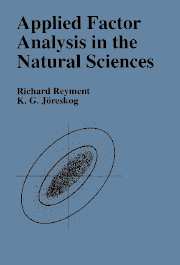Book contents
- Frontmatter
- Contents
- Preface
- Glossary of the most commonly used symbols
- Preface to first edition
- 1 Introduction
- 2 Basic Mathematical and Statistical Concepts
- 3 Aims, Ideas, and Models of Factor Analysis
- 4 R-Mode Methods
- 5 Q-Mode Methods
- 6 Q-R-Mode methods
- 7 Steps in the Analysis
- 8 Examples and Case Histories
- Appendix: Computer programs
- Bibliography
- Index
5 - Q-Mode Methods
Published online by Cambridge University Press: 12 November 2009
- Frontmatter
- Contents
- Preface
- Glossary of the most commonly used symbols
- Preface to first edition
- 1 Introduction
- 2 Basic Mathematical and Statistical Concepts
- 3 Aims, Ideas, and Models of Factor Analysis
- 4 R-Mode Methods
- 5 Q-Mode Methods
- 6 Q-R-Mode methods
- 7 Steps in the Analysis
- 8 Examples and Case Histories
- Appendix: Computer programs
- Bibliography
- Index
Summary
INTRODUCTION
An objective of many investigations is to classify a sample of objects (rock specimens, fossils, water samples, environments, etc.) on the basis of several properties, Specimens, Q-mode analysis, as first applied in geology by Imbrie (1963), is a valuable aid in doing this in cases where there are a large number of objects and, especially, where there is little a–priori knowledge of the significance of the constituents. The concept of Q-mode analysis was first developed by psychologists and then by biologists.
Q-mode analysis are designed to portray interrelationships between objects, just as in R-mode analyses interrelationships between variables are analyzed. To a certain extent, factor scores derived from R-mode analysis provide a means of describing interobject relationships; however, these associations are not usually based on a suitable measure of interobject similarity. That is, the covariance or correlation may not be the best criterion by which to judge the degree of similarity between two objects.
The mainstay of Q-mode factor analysis lies with the definition of interobject similarity. Once a suitable mathematical definition of this similarity coefficient has been established, it is possible to assemble an N × N similarity matrix containing the degree of similarity between all possible pairs of N objects. When N is large, this matrix will contain many elements and finding its rank by eigenanalysis may provide a means of adequately describing the objects in terms of fewer basic dimensions than original variables.
We describe here two methods of Q-mode analysis. The Imbrie Q-mode method defines similarity with respect to the proportions of constituents.
- Type
- Chapter
- Information
- Applied Factor Analysis in the Natural Sciences , pp. 136 - 171Publisher: Cambridge University PressPrint publication year: 1993



